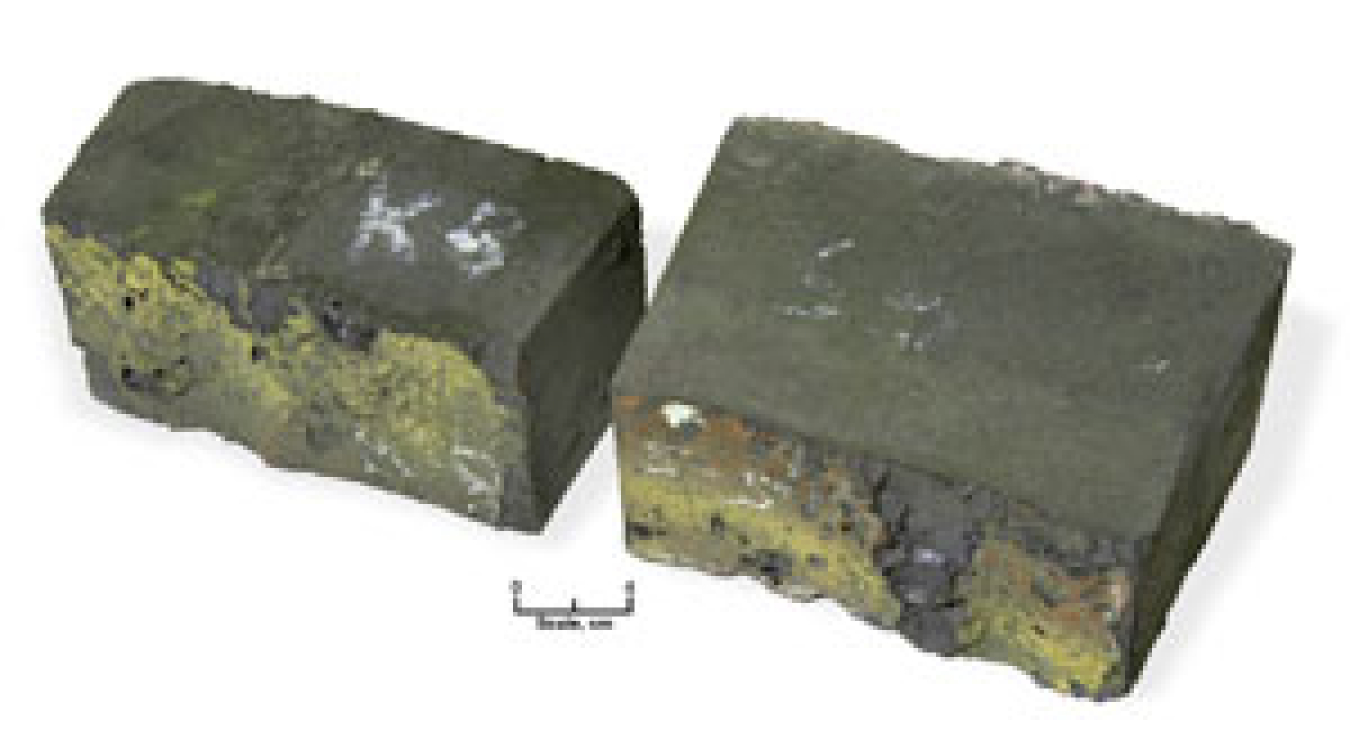
Refractories removed from adjacent positions in a slagging gasifier. The NETL refractory (right) has approximately 50 percent more material remaining after the test.
Washington, DC - A new improved-performance refractory lining material developed by the Office of Fossil Energy's National Energy Technology Laboratory (NETL) has been successfully tested and could lead to greatly increased reliability and economics of gasification technology as a clean and efficient process.
The NETL developed refractory was jointly researched with Harbison-Walker Refractories Company of Pittsburgh, PA; patented in 2003; and transferred via license to Harbison-Walker Refractories Co. for production and marketing as a refractory liner material for commercial gasifiers. It is marketed under the product name AUREX95P. Subsequent testing in both power generation and chemical production applications rated the refractory as "excellent" or "exceptional" in terms of both increasing service life in high-wear areas of the gasifier, and in lowering operational costs.
Refractory materials are used to line the interior of slagging gasifiers, where a carbon-based feedstock (such as coal, petroleum, coke, and/or biomass) is converted at high temperatures in an oxygen short atmosphere into hydrogen and carbon monoxide, called synthesis gas. The refractory lining is necessary to protect the steel shell of the gasification chamber from the harsh environment necessary for the gasification process; which includes elevated temperature and pressures, reactive gases, thermal shock, and corrosive slags resulting from mineral impurities in the carbon feedstock that liquefy during the gasification process.
The syngas produced by gasification can be used in power generation, to produce transportation fuels, as a source of hydrogen in hydrogen based economy, and as a chemical feedstock in other industrial processes. Environmental pollutants such as SOx and mercury can easily be captured, along with carbon dioxide (a major greenhouse gas) for sequestration or use in other industrial processes.
Refractory materials that can withstand severe operating conditions for long periods of time are necessary for a continuous, efficient, and reliable gasification process. The traditional high chrome oxide refractory used to line gasifiers fail in 3 to 24 months, requiring complete shutdown of the unit for material replacement. The poor service life has been a major factor contributing to poor on-line gasifier availability and reliability, limiting wider commercial deployment of gasification.
The AUREX 95P is a phosphate-modified high-chrome oxide material which increases material service life (50 percent in field trials versus conventional liner materials) by reducing slag penetration and structural spalling at the refractory hot face, one of the primary causes of liner failure.
The continued advancement of gasification technology requires new and improved refractory materials, such as the AUREX 95P, that will increase the cycle time between maintenance shutdowns and will increase the reliability and availability of the gasifier. The AUREX 95P represents the most significant improvement in gasifier refractories in over 25 years, and will help eliminate roadblocks that limit the use of gasification technology for electric power and other product production.
NETL, operated by the Department of Energy's Office of Fossil Energy, has been a leader in developing coal gasification technologies and transferring them to the public domain for commercial deployment. NETL coordinates its Gasification Systems Technologies program with other DOE programs, national laboratories, and private organizations to ensure efficient technology development and transfer with maximum return on investment of tax dollars. Gasification combined with carbon capture and storage is likely to be a core technology for future power plants.
<p>FECommunications@hq.doe.gov</p><p> </p>
